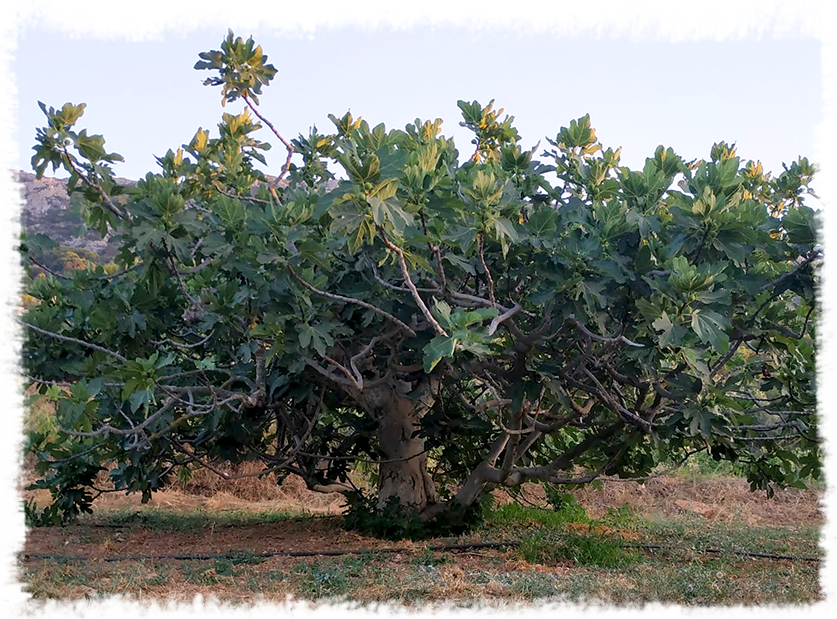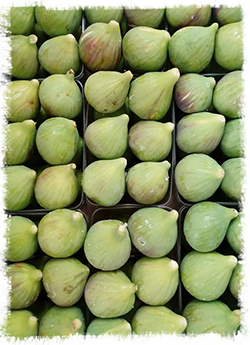A little bit of history...
 The beginning of fig cultivation dates back to prehistoric times. The fig tree probably originated in Asia from where its cultivation spread throughout the Mediterranean. It was among the most common trees that the ancient Greeks cultivated and the figs of Attica were famous and sought after in all of the greek world. We can find references to the fig in many ancient writers and myths: Homer, in the last rhapsody of Odyssey tells us that Odysseus convinced his father Laertes of his identity by reminding him that "Pear-trees thirteen thou gavest me, and ten apple-trees, and forty fig-trees.". The poet Archilochus records the art of fig cultivation for the first time around 700 BC. The fig tree was sacred to the ancient Greeks. In Laconia, they considered it as the sacred tree of god Dionysus and it was believed that the god himself had planted a tree at the entrance to the underworld. The traveler and geographer Pausanias also tells us the story of mythical Phytalos to whom goddess Demeter, the goddess of agriculture, taught how to cultivate the tree. Figs, dried or fresh, were one of the basic foods of the ancient Greeks. They consumed them together with bread, honey, almonds, walnuts and other dried nuts. The figs were often dried in the sun in order to maintain them for longer periods of time, resulting in a very sweet and with high caloric content product, called "ischades". Greece, even to this day produces excellent quality fresh and dried figs that travel all around the world!
The beginning of fig cultivation dates back to prehistoric times. The fig tree probably originated in Asia from where its cultivation spread throughout the Mediterranean. It was among the most common trees that the ancient Greeks cultivated and the figs of Attica were famous and sought after in all of the greek world. We can find references to the fig in many ancient writers and myths: Homer, in the last rhapsody of Odyssey tells us that Odysseus convinced his father Laertes of his identity by reminding him that "Pear-trees thirteen thou gavest me, and ten apple-trees, and forty fig-trees.". The poet Archilochus records the art of fig cultivation for the first time around 700 BC. The fig tree was sacred to the ancient Greeks. In Laconia, they considered it as the sacred tree of god Dionysus and it was believed that the god himself had planted a tree at the entrance to the underworld. The traveler and geographer Pausanias also tells us the story of mythical Phytalos to whom goddess Demeter, the goddess of agriculture, taught how to cultivate the tree. Figs, dried or fresh, were one of the basic foods of the ancient Greeks. They consumed them together with bread, honey, almonds, walnuts and other dried nuts. The figs were often dried in the sun in order to maintain them for longer periods of time, resulting in a very sweet and with high caloric content product, called "ischades". Greece, even to this day produces excellent quality fresh and dried figs that travel all around the world!
...and botany

| Nutrient | per 100g |
|---|---|
| Water | 79,11 g |
| Calories | 74,0 kcal |
| Proteins | 0,75 g |
| Fibers | 2,9 g |
| Sugars | 16,26 g |
| Cholesterol | 0 g |
| Calcium | 35,0 mg |
| Potassium | 232,0 mg |
| Magnesium | 17,0 mg |
| Iron | 0,37 mg |
| Vitamin A | 142,0 IU |
| Vitamin C | 2,0 mg |
Sweet flavour & great nutritional value!
Fig, a fruit associated with greek summer does not only have a great flavour but also a great nutrinional value. They are a rich source of dietary fibers and therefore they 're considered to be of great benefit for people with digestive issues. Figs also have high concentrations of calcium and potassium, higher than most other similar fruits. Their high concentration in potassium, in combination with the absense of cholesterol and sodium can have a beneficial effect on high blood pressure while potassium also plays a vital role in the proper function of our muscles and nervous system. Other trace elements, like iron and magnesium are also present as well as prebiotics, vitamins (mainly vitamin-C and B-complex vitamins) and antioxidants like bete-carotene and polyphenols. A portion of 5 fresh figs will provide about 185 kcal of energy, 2 g of proteins and 4 g of dietary fibers making figs a perfect healthy snack! You can consume it without peeling off the skin, since it contains many nutrients but most people prefer to remove it. Try it as a quick and healthy snack, in salads, together with cold cuts like prosciutto, even with pasta! Check out our recipes for a fig jam, a refreshing salad and a fresh pasta dish!

